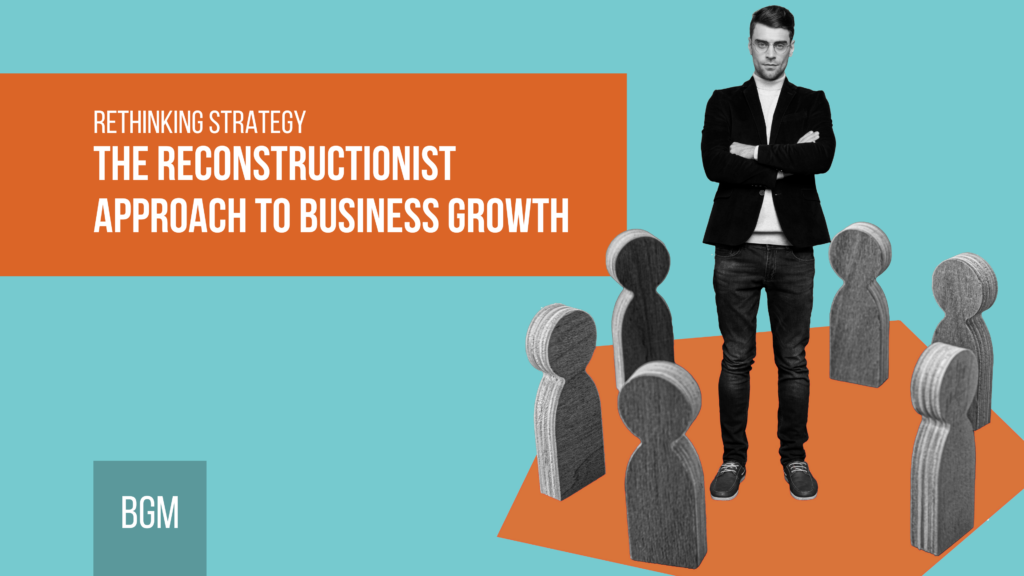In highly competitive markets, businesses often focus on outperforming rivals within existing industry rules. They invest heavily in marketing, price wars, and operational efficiencies to stay ahead. However, these traditional strategies often lead to diminishing returns and stagnation.
What if, instead of competing within fixed boundaries, businesses redefined the playing field entirely? The reconstructionist view of strategy encourages companies to shift their focus from competing with others to creating new value that changes the industry landscape itself.
Let’s explore what this approach means, why it matters, and how businesses can adopt it to drive innovation and long-term success.
What Is The Reconstructionist View Of Strategy
The reconstructionist approach challenges conventional thinking by encouraging businesses to reshape industry boundaries instead of fighting for a position within them. Unlike traditional strategies, which focus on incremental improvements and competition within known markets, reconstructionist strategy aims to create new demand by offering innovative value to customers.
It is closely linked to concepts like Blue Ocean Strategy, where businesses don’t just compete-they change the rules of the game.
Key differences between traditional competitive strategy and reconstructionist strategy:
- Traditional Strategy – Focuses on gaining a competitive advantage within an existing industry by reducing costs, increasing efficiencies, or improving marketing efforts.
- Reconstructionist Strategy – Redefines industry norms by introducing new business models, services, or products that eliminate the need for direct competition.
Rather than accepting industry limitations, reconstructionist businesses ask.
- Can we serve an overlooked customer segment?
- Can we deliver our product or service in a way that is completely different from the competition?
- Can we remove unnecessary complexity to offer greater value?
Instead of following the industry standard, businesses that embrace reconstructionist strategy create entirely new market spaces and uncontested growth opportunities.
Why Rethink Industry Boundaries Instead Of Competing
Businesses that remain stuck in traditional competition cycles often experience.
- Shrinking profit margins due to price wars
- Overcrowded markets where differentiation is difficult
- Slower growth as new entrants flood the space
- Limited customer loyalty as buyers constantly seek better deals
Reconstructionist thinking allows businesses to
- Discover new market opportunities by identifying unmet needs and underserved customer segments.
- Break free from price wars by offering a unique value proposition rather than just competing on cost.
- Create demand instead of competing for existing demand-which often results in higher customer loyalty and pricing power.
- Future-proof the business by leading industry change rather than reacting to it.
- When businesses rethink the way their industry operates, they set the terms for growth rather than adapting to external pressures.
How To Shift Focus From Competition To Value Creation
For businesses looking to implement a reconstructionist strategy, the goal is to move away from competing for existing customers and instead focus on creating new value. Here’s how:
1. Identify And Remove Industry Assumptions
Many industries operate based on accepted norms-rules that everyone follows because “it has always been done this way.” Businesses that break through these assumptions often reshape industries.
Ask
- What rules or practices in my industry no longer serve customers?
- What would happen if we eliminated a major cost driver that customers don’t value?
Example – Netflix vs. Traditional Movie Rental
Blockbuster relied on physical stores and late fees for revenue. Netflix removed the need for both-reshaping the home entertainment industry by offering unlimited streaming and subscriptions.
2. Look Beyond Current Customers
Most businesses focus on serving their existing customer base, but a reconstructionist strategy looks at non-customers – people who might engage with an industry differently if offered the right solution.
Ask
- Why are some people NOT using our industry’s products or services?
- Can we offer a more accessible or simplified version to attract them?
Example – Afterpay and the Finance Industry
Traditional credit card companies charged high interest rates, discouraging many consumers from using credit. Afterpay restructured consumer finance by offering a no-interest, instalment-based payment model – attracting new customers who avoided traditional credit.
3. Reduce Or Eliminate Unnecessary Complexity
Many industries over-complicate products and services, assuming that more features = more value. However, simplifying offerings often makes them more appealing to customers.
Ask
- Are we adding complexity or extra costs that customers don’t actually need?
- Can we simplify our model and make it more user-friendly?
Example – Canva vs. Traditional Design Software
Adobe Photoshop is powerful but complex. Canva made graphic design accessible to non-designers by offering pre-made templates and drag-and-drop tools expanding the market beyond professionals.
4. Find Unaddressed Pain Points
Instead of trying to outperform competitors, focus on solving major frustrations that others overlook. Businesses that identify pain points create more meaningful value.
Ask
- What problems does our industry ignore that frustrate customers?
- How can we remove the biggest barrier to adoption?
Example – Uber vs. Traditional Taxis
Taxis were plagued with long wait times, cash-only payments, and unpredictable fares. Uber removed these pain points by introducing app-based booking, digital payments, and fare transparency-reconstructing the entire transport industry.
Rethinking The Rules Of Growth
Competing harder in a saturated market often leads to diminishing returns. But businesses that choose to think differently – those who adopt a reconstructionist approach – position themselves to lead rather than follow.
Instead of asking, “How do we beat the competition?” Start asking, “How do we change the game?”.
By challenging long-held industry assumptions, focusing on unmet customer needs, and stripping away unnecessary complexity, you move beyond the fight for market share and begin to shape an entirely new space-one where your business stands alone.
We’re here to support your journey in reimagining strategy and creating uncontested market space. If you have a topic you’d like us to explore in future newsletters, let us know-we’d love to hear from you.
Live with purpose,
Kristian Livolsi and the Business Growth Mindset Team




